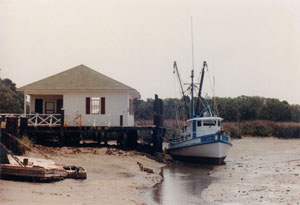| page last updated |
 |
River Tour | Estuary | Salt Marsh | |
| What is an Estuary? > Climate > Geology > Surface Water > Ground Water > Aquatic Habitat > Upland Habitat > Ecological Processes > Animals and Plants > Socioeconomic Values > Human Impacts and Pollution > Where does Your water come from? > Management Issues > Protecting YOUR Watershed | ||
|
K-12
Students Site
|
||
| What is an Estuary > Altamaha River Watershed > Water Cycle > Hydrology > Tides > Animals and Plants | ||||||
|
Tides are the alternating rise and fall of sea levels. Around the world, water levels in seas and the rivers connected to them rise and fall approximately twice a day. Tides should not be confused with waves. Waves are large ripples that move across the surface of water. Waves are caused by wind. Tides are caused by the gravitational pull of the moon and the sun on the earth and its waters. The moon has a stronger effect than the sun because the moon is closer to earth. To understand when and why tides rise and fall, you must consider astronomy. The earth makes one complete rotation on its axis per day. Therefore, a site on earth will face the moon once a day. For any place on earth, high tide occurs when the site is nearest (faces) the moon. Water levels rise as the moon's gravity pulls on the earth's water. The second time this site experiences high tide is when the site is farthest from the moon (about twelve hours later). Here, the moon's gravity is weakest. The water withstands being pulled away by the moon. Also, the centrifugal force of the spinning earth contributes to this high level of water. After each period of high tide, a low tide occurs at the site. The earth turns, and the site no longer faces the moon, nor faces directly away from the moon. Sea and river levels lower as the moon pulls water away. A rising tide is called a flood tide. As ocean levels rise, seawater along the coast is pushed up into rivers that are connected to the ocean. The flood tide introduces seawater into the freshwater environment of the river. Flood tides may travel as fast as 25 km (15 miles) per hour. They may temporarily reverse downstream current, so that the river flows upstream during the flood tide! A falling tide is called an ebb tide. As ocean levels fall, the shoreline retreats seaward. During an ebb tide, water currents carry freshwater and sediments from rivers out into the sea. Sediments from the river help nourish sea life along the shore. During certain days of the month, high tides are especially high, and low tides are especially low. These are called spring tides. They occur about twice a month. Spring tides are also the result of astronomy (they are not related to the season spring, which begins in the month of March). The moon makes one revolution around the earth each month (once every 29.5 days). Spring tides occur when the moon is lined up with the earth and sun (see picture). This happens two ways: when the moon is in between the earth and the sun, and when the moon and sun are on opposite sides of the earth. The gravity of the sun and moon line up and cause these especially high tides. When the sun and moon are at right angles to the earth, neap tides occur (see picture). During neap tides, high and low tides are less exaggerated than during spring tides. This is because the gravity of the sun and moon pull on the earth's water from conflicting angles. |
 |
|||||
| Boat tied up to dock at low tide. Click on the picture for a larger view. At high tide the water level is near the dock walkway. | ||||||